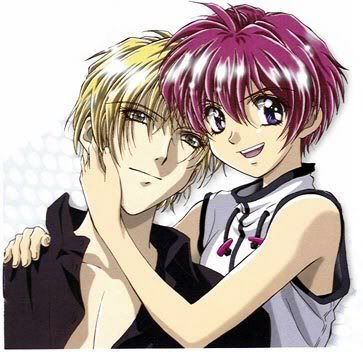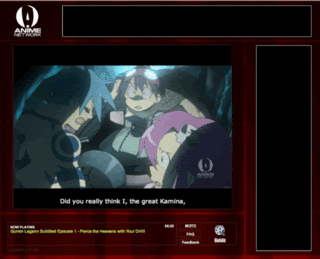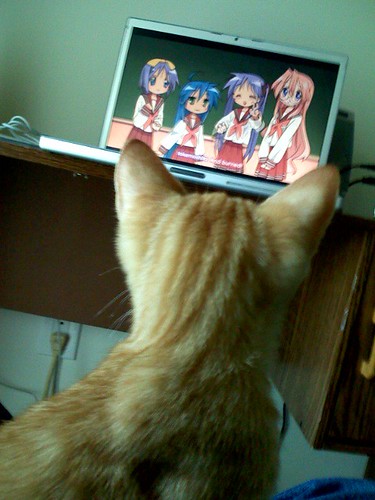Scott finishes his series of posts from the first annual New York Anime Festival.

I am a connoisseur of entertainment, especially when it comes to television and anime. I watch it for hours every night after work, and I am easily the one to go to for all the latest on what’s on the air right now. But there is one interesting fact about my love of TV that seems shocks everyone when I mention it –
I don’t have cable, satellite, or any other service like that.
I simply don’t need it. My entertainment setup is an HDTV hooked up to a Mac Mini computer and up-converting DVD player. With my Verizon fiber-optic internet connection and a subscription to Netflix, I have access to so much programing that I’ll never be able to watch it all. I can easily download or stream the latest TV shows right onto that computer, or I can have Netflix mail me any DVD I want the next day.
That is just the world we’re living in today. The internet has made entertainment more convenient and easy to consume as ever. But the big question is now that we have all this wonderful technology, how does the entertainment industry adapt its business model?
The music industry has already tackled this issue with supporting legal download services. iTunes and Amazon’s MP3 service are highly successful, and now record labels are throwing more support by eliminating Digital Rights Management (DRM) restriction on these songs, allowing these legal downloads to be used freely even under modern copyright laws. The television industry is also adapting by offering their content online and streaming for free. Websites like Hulu.com and Adult Swim Videos show brand new episodes right after they are broadcast, sometimes even before they are broadcast! The content is supported by the occasional advertisement, but it’s well worth it for brand new TV shows anytime that you want to watch them.
That is the great financial potential that the internet can offer to the entertainment industry. It’s so powerful, in fact, that the Writer’s Guild of America is currently on strike to insure that they get properly compensated when everyone switches from broadcast to the net.
So the reason I bring up all this background is so that I can ask the following question:
Where the hell is the anime industry during all of this?
It should be pretty obvious that the internet and the US anime industry go hand-and-hand. In the year 2000, the anime show Love Hina became the first series to become a hit in America from being widely circulated on college file-sharing networks. By penetrating that key age 18-24 male demographic, it opened up interest in anime to become something more than just the Pokémon and Dragonballs of the time. Within years there was a booming market for anime DVDs and manga in America.
But as the DVD and manga market grew, so did anime file-sharing. Broadband connections become more affordable, so even normal households had the potential to download full video files. New technologies like Bittorent and Youtube made this task even faster and more efficient. Eventually, people got used to the idea of watching videos over the internet, and people like myself went that extra step to hooking up a computer into their home television system.
Anime was always unique when it came video files. It always had to be imported from Japan and translated into English. This extra step put it at a disadvantage over domestic TV shows. While companies did their best to get the product out as quickly as possible, the cost of production and labor was often too restrictive. Most anime either never makes it to America, or they do so years after they initially air in Japan.
That is where the internet becomes the most helpful. With an unlimited supply of anime fans with free time, shows can become collected, subtitled, and than redistributed within hours of its initial airing on television. This “fansubbing” process works very quickly, and continues to work even eight years after Love Hina.
You would think that with a successful and well established process in place, the American anime industry would try its best to adapt itself to get into that market. Right?
I’ve asked this question in the past whenever I go to anime conventions, and every year, the industry reps look at me like I’m some kind of idiot. Of course they can’t make a dime off of that fansub community. Those goddamn pirates are already a lost cause. The best solution was to snatch up every title and release them all on DVD to the people who will buy them. They really thought that this was where the future of the American anime industry lived. And with booming DVD sales, who was I to doubt them?
But that was not the right solution, and it started to become painfully obvious around the time of Anime Boston 2006. The DVD market was over-saturated. Companies were starting to lose their momentum, and many of them didn’t even show up. Only a few new titles were announced. It was pretty pathetic.
I wrote a very bitter entry on this sad state. I blamed the fansub community for not supporting the industry like they should have, but I also blamed the industry for not embracing the fansub community and changing their business model. Once again, all my questions of online distribution were brushed off completely up in Boston that year.
What a difference 18 months make.
The American anime industry had a new message to say at the New York Anime Festival, and it was “Our future is on the internet.”
Well, don’t say I didn’t tell you so. 😉
It appears that now that normal TV markets have entered the online business, it is safe for anime to do so as well. Manga Entertianment, Viz Media, and Tokyopop dedicated half of their panels on the subject. Within the past year, some companies have already offered up their shows on services such as iTunes and the Xbox Live Marketplace. These companies mentioned these services, but also boasted about their own initiatives into the market.
Manga Entertainment had the biggest presentation as they debut their new website. The website contains many clips from their titles, as well as links pointing to every possible retail outlet for the show. You can tell that they put a lot of work into providing as much information as they could for the website, and they strongly encourage visitors to legally download the shows from the different services available.
Tokyopop had the most unusual online plan that even a tech-savvy guy like myself still does not understand. They are creating “interactive manga” for use on computers, cell phones, and other portable devices. They showed off some demos, which I can best describe as a series of static artwork moving around with music and voice actors. One title even had some CGI animation created for it. They showed them as if they were being played on a cell phone (pictured above) or on an iPhone / iPod Touch. When I asked how was it going to be possible for the consumer to get these videos on their devices, the spokesperson could not seem to come up with an answer.
And ADV films announced that they were going to do some big things with their new title Gurren-Lagann. We all found out the next week what that was…
I’m happy to say that my question this year wasn’t “What about going to online distribution?” but rather, “now that you’re distributing online, how do you plan to improve the service?” The way I see it, there are two major hurdles that the anime industry needs to take care of in this new market: cost and DRM restrictions.
DRM is my biggest gripe. As a Mac user, there is only one download service that I can use, iTunes. Amazon Unboxed, Netflix, and all other forms of DRM’ed videos are all based on Microsoft Windows and will not play at all on any of my computers or on my iPhone.
Manga Entertainment was my first easy target. They have video downloads for sale on Windows-only DRM services. So to promote their new website, they held a contest to win a free iPod Touch for those at the convention. Once the Q&A came around, I asked them the obvious question. “If I pay to download a video from you, how am I going to be able to play it on that iPod Touch?” Again, that DRM would prevent them from playing on any iPods.
They took the question very seriously, and said that the reason they were giving out the iPods is because they were close to striking a deal with a particular company to get their shows on it. They were implying that the company was Apple, and that means that they’re shows will soon be available on iTunes. But as of this post, they’re still not on there.
And Viz Media spent so much talking about all the differant partnerships with online download services that they didn’t even have time for a Q&A. That’s a real shame, because all of those partnerships they were talking about were all for Windows DRM’ed services, and Viz’s very own laptop has a glowing apple on it.

I would say that’s the price I pay for going with a unique operating system, but come on. You can’t ignore the fact that not only were most of the journalist were using Mac, but even the industry panelist were giving their presentations on Mac computers! The anime audience is comprised of many Mac users, and the industry should realize this and move away from Windows-only DRM.
Or better yet, take a note from the music industry and just get rid of DRM all together. Fansubs are not DRM’ed, so they are open enough for both Windows and Mac anime fans to enjoy. What are you gaining from DRM? Are you afraid that these shows will more easy to pirate if you do restrict them? How is that any different than the current situation with fansubs? If a person buys a video with his own money, he owns it. It is his property. Wouldn’t he feel more inclined to protect his own property and not have others steal it? I’ll only let my best friends “borrow” music I bought from iTunes and Amazon. Anyone else can just buy their own damn copy.
DRM on videos will eventually go away, just like it is with music. I just hope the anime industry has the sense to do it first before everyone else does.
And then comes the issue of “free” versus “paid” services. I bought a couple of FUNimation’s shows off of iTunes. Spending 40 bucks on the whole season of Tsukuyomi -Moon Phase- seemed worth it to me, but I felt like spending $2 episode-per-episode off of Xbox to be too much. Was I crazy for actually spending all that money for that show? Are people really shelling out the cash to convince these companies “this is where we should be heading?”
I asked this to FUNimation as they were giving their presentation on their download services. Were their ventures into iTunes and the Xbox Live Marketplace really that profitable?
“Of course it’s profitable!” he tells me with not hesitation. “We wouldn’t be doing this if it wasn’t. The truth is, we want to put all of our titles on these pay-per-download services, and we are currently in talks with the Japanese license holders to make that happen.”
So there you go. One company clearly sees the financial potential of the internet and is going forward with moving into that market. But even if a paid service is too much for some anime fans, going to an ad-supported streaming service will also be a profitable solution. This is ADV’s plan for the future. By putting their material for free on the internet, they are not at risk of losing even more money than they were before. Collectors will still buy the DVD, and fansubbers will still download for free. The only difference is that now you can also profit off of the fansubbers with ads. As long as you make the experience easy and convenient, you can win over that community.
However, it seemed to me that there was still one company who still didn’t see any potential in the internet. That would be our good friends at Bandai. Bandai was one of the first to launch a download service well over a year ago with Eureka Seven. After a week of being free, each episode became very expensive. I think $5 each, but I’m not sure. That is because in both cases, the episode was DRM’ed for Windows only, so I never got to see any of it. Mr. Iyadomi, who was confident about the service before, denounced it as a complete failure at NYAF. They are giving up, and have no current plans to go back into the online market.
(on a side note, I really hope Iyadomi-bashing doesn’t become a recurring theme for me)
But I have a feeling Bandai will be regretting that early forfeit very soon. If there was one clear message I got form the American anime industry at the NYAF, it was that we are at the dawn of the internet revolution. After eight years of fighting, companies are finally changing their business model to embrace the online fansub community. Some are already seeing the benefits of doing so. Others are just dipping their feet into the water. And while there are some major hurdles that still need to be overcome, they will eventually get there.
I’m just hoping it happens sooner rather than later. 😉











